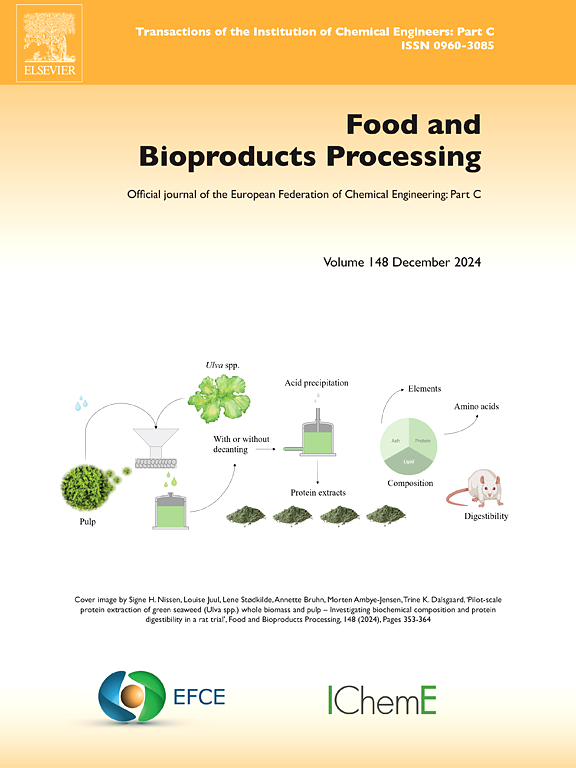From residues to clove: Harnessing novel phenolic acid decarboxylase for 4-Vinyl guaiacol production in industrial Yeast
IF 3.4
2区 农林科学
Q2 BIOTECHNOLOGY & APPLIED MICROBIOLOGY
引用次数: 0
Abstract
Growing demand for sustainable alternatives to petroleum-derived aromatic compounds highlights lignocellulosic biomass as a potentially valuable resource. Although cellulose and hemicellulose, the major components of lignocellulose, are widely used in biofuel and chemical production, lignin, another predominant plant biomass component, remains underutilized. Chemical pretreatment methods for lignocellulose, such as mild alkali, can release cross-linked hydroxycinnamic acids such as ferulic acid, a precursor to various aroma compounds such as 4-vinyl guaiacol (4-VG), which has a clove-like aroma. To improve 4-VG production, an industrial strain of Saccharomyces cerevisiae Ethanol Red™ was engineered to express a novel phenolic acid decarboxylase (PDC) gene from Rhodosporidium fluviale LM-2, Rf_PDC_B. Mutant strain expressing Rf_PDC_B achieved 4-VG levels comparable to those reported in the literature after 48 h of fermentation using maize pericarp hydrolysate as the substrate, demonstrating efficient biotransformation of ferulic acid from lignocellulosic hydrolysates into 4-VG. In summary, a transformed cell line was created for the direct biocatalytic production of aromatic compounds from lignocellulosic hydrolysates. This study contributes to the development of novel technologies related to the sustainable production of high-value compounds derived from lignin.
从残留物到丁香:利用新型酚酸脱羧酶在工业酵母中生产4-乙烯基愈创木酚
对石油衍生芳香族化合物的可持续替代品的需求日益增长,凸显了木质纤维素生物质作为一种潜在的宝贵资源。尽管木质纤维素的主要成分纤维素和半纤维素广泛用于生物燃料和化学生产,但另一种主要的植物生物质成分木质素仍未得到充分利用。木质纤维素的化学预处理方法,如温和的碱,可以释放交联羟基肉桂酸,如阿魏酸,是各种香气化合物的前体,如4-乙烯基愈创木酚(4-VG),具有丁香般的香气。为了提高4-VG的产量,对一株酿酒酵母乙醇红(Ethanol Red™)工业菌株进行了工程改造,使其表达一种新的来自fluviale红孢子虫LM-2 (Rf_PDC_B)的酚酸脱羧酶(PDC)基因。以玉米果皮水解液为底物发酵48 h后,表达Rf_PDC_B的突变菌株获得了与文献报道相当的4-VG水平,表明阿威酸从木质纤维素水解液有效地转化为4-VG。总之,建立了一种转化细胞系,用于从木质纤维素水解物中直接生物催化生产芳香族化合物。该研究有助于开发与可持续生产木质素衍生高价值化合物相关的新技术。
本文章由计算机程序翻译,如有差异,请以英文原文为准。
求助全文
约1分钟内获得全文
求助全文
来源期刊

Food and Bioproducts Processing
工程技术-工程:化工
CiteScore
9.70
自引率
4.30%
发文量
115
审稿时长
24 days
期刊介绍:
Official Journal of the European Federation of Chemical Engineering:
Part C
FBP aims to be the principal international journal for publication of high quality, original papers in the branches of engineering and science dedicated to the safe processing of biological products. It is the only journal to exploit the synergy between biotechnology, bioprocessing and food engineering.
Papers showing how research results can be used in engineering design, and accounts of experimental or theoretical research work bringing new perspectives to established principles, highlighting unsolved problems or indicating directions for future research, are particularly welcome. Contributions that deal with new developments in equipment or processes and that can be given quantitative expression are encouraged. The journal is especially interested in papers that extend the boundaries of food and bioproducts processing.
The journal has a strong emphasis on the interface between engineering and food or bioproducts. Papers that are not likely to be published are those:
• Primarily concerned with food formulation
• That use experimental design techniques to obtain response surfaces but gain little insight from them
• That are empirical and ignore established mechanistic models, e.g., empirical drying curves
• That are primarily concerned about sensory evaluation and colour
• Concern the extraction, encapsulation and/or antioxidant activity of a specific biological material without providing insight that could be applied to a similar but different material,
• Containing only chemical analyses of biological materials.
 求助内容:
求助内容: 应助结果提醒方式:
应助结果提醒方式:


